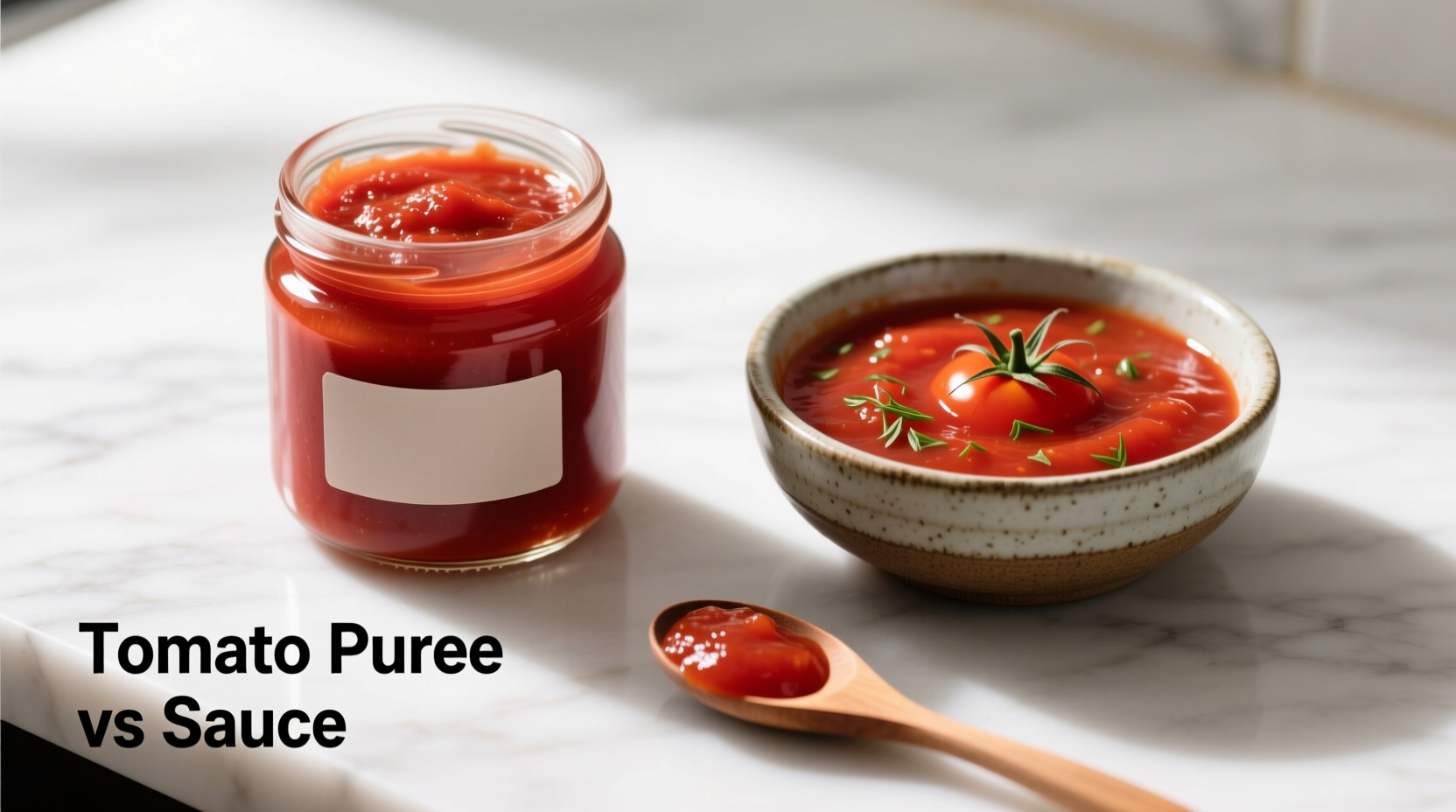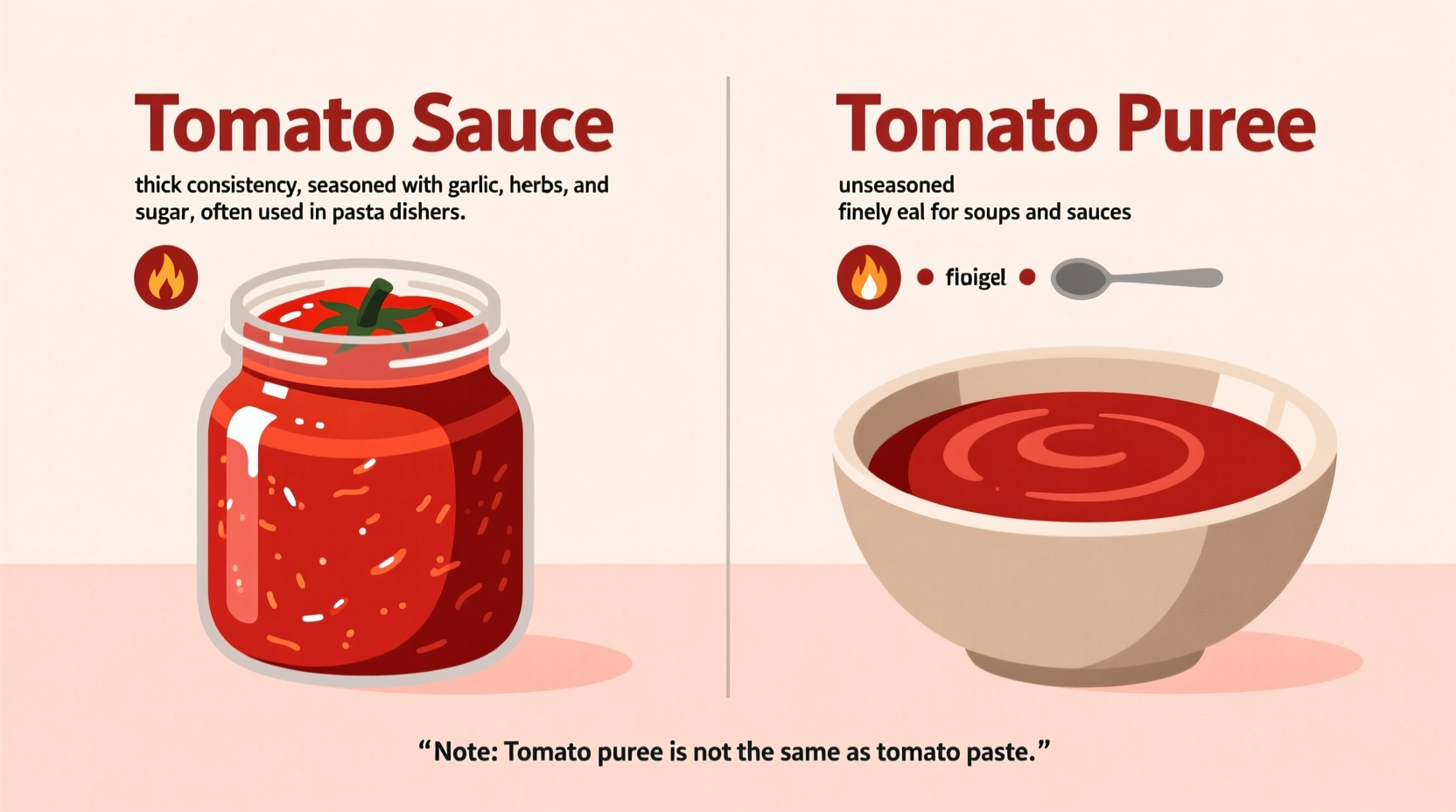Tomato sauce contains added seasonings and is thinner (6-8% tomato solids), while tomato puree is thicker (8-24% solids) with no added ingredients—making puree ideal for concentrated flavor in sauces and sauce better for ready-to-use applications.
Why This Difference Matters in Your Cooking
Understanding the distinction between tomato sauce and tomato puree isn't just culinary trivia—it directly impacts your dish's texture, flavor concentration, and cooking time. Many home cooks accidentally use these interchangeably, resulting in sauces that are too watery or overly intense. Let's break down exactly what sets them apart and how to use each properly.
Core Differences at a Glance
| Characteristic | Tomato Puree | Tomato Sauce |
|---|---|---|
| Tomato Solids Content | 8-24% (thicker consistency) | 6-8% (thinner consistency) |
| Added Ingredients | None (just tomatoes) | Salt, sugar, herbs, spices |
| Processing Method | Double-cooked to concentrate flavor | Single-cooked with seasonings added |
| Typical Culinary Use | Base for complex sauces, soups, stews | Ready-to-use in pasta dishes, pizza |
| Shelf Life (unopened) | 24 months | 18 months |
How Food Regulations Define These Products
The U.S. Food and Drug Administration (FDA) establishes clear standards that differentiate these products. According to FDA regulations on tomato products, tomato puree must contain a minimum of 8% tomato solids with no added ingredients, while tomato sauce typically contains 6-8% solids plus seasonings. This regulatory distinction explains why puree delivers more concentrated tomato flavor without competing flavors.
Texture and Consistency: The Practical Difference
When you open a can, the physical difference is immediately apparent. Tomato puree has a thick, almost paste-like consistency that holds its shape when spooned. It requires dilution with liquid before use in most recipes. Tomato sauce flows more freely and often contains visible herbs or seasoning particles.
Professional chefs measure this difference precisely: puree typically has a Brix level (sugar content measurement) of 8-10°, while sauce measures 5-6°. This seemingly small difference significantly impacts how each behaves during cooking—puree reduces further to intensify flavor, while sauce maintains its consistency.

When to Use Each: Practical Kitchen Guidance
Choosing the right product depends on your cooking goals:
Reach for Tomato Puree When:
- You're building complex sauces from scratch (marinara, arrabbiata)
- Creating soups or stews where tomato flavor should dominate
- Need a thick base that won't water down your dish
- Planning to add your own seasonings for custom flavor profiles
Choose Tomato Sauce When:
- You want a ready-to-use product for quick meals
- Preparing simple pasta dishes with minimal additional ingredients
- Using in recipes that specifically call for pre-seasoned tomato product
- Short on cooking time but still want decent flavor
Common Substitution Mistakes and Solutions
Many recipes use these terms interchangeably, causing confusion. If substituting:
- Using sauce instead of puree: Simmer uncovered for 15-20 minutes to reduce liquid content, or use 25% more sauce than puree called for
- Using puree instead of sauce: Dilute with equal parts water or broth and add 1/4 teaspoon salt plus herbs per cup of puree
- For pizza: Always use sauce—puree will burn during baking due to higher concentration
- For slow cooker recipes: Puree works better as it won't over-dilute during long cooking
Reading Labels Like a Pro
Don't be fooled by marketing terms. Some products labeled “tomato sauce” are actually puree, and vice versa. Check the ingredient list:
- True tomato puree lists only “tomatoes” or “tomato puree”
- Tomato sauce will include salt, citric acid, and often herbs
- “Tomato paste” is even more concentrated than puree (24-30% solids)
- Avoid products with “tomato product concentrate”—this indicates lower quality
Professional Chef Insights
According to culinary research from the Culinary Institute of America, professional kitchens maintain separate stocks of both products for specific applications. Chefs prefer puree as a blank canvas for signature sauces, while keeping pre-seasoned sauce for staff meals and quick service. The institute's flavor development studies show that puree's concentrated form allows for better Maillard reaction development during sautéing, creating deeper flavor complexity.
Storage and Shelf Life Considerations
Both products have similar shelf lives when unopened (18-24 months), but behave differently after opening:
- Tomato puree: Lasts 5-7 days refrigerated in airtight container
- Tomato sauce: Lasts 7-10 days refrigerated due to added salt content
- Both can be frozen for up to 6 months in ice cube trays for portion control
- Discard if you notice bubbling, off-odors, or mold growth
Global Variations to Consider
Terminology differs internationally, which explains much of the confusion:
- In the UK, “tomato passata” refers to what Americans call puree
- Italian “passata di pomodoro” is uncooked puree, while “sugo” indicates sauce
- Many European products labeled “tomato sauce” contain no added seasonings
- Always check ingredient lists when using imported products
Maximizing Flavor in Your Dishes
For the best results, consider these chef-recommended techniques:
- Sauté puree in olive oil for 2-3 minutes before adding liquids to deepen flavor
- Add a pinch of baking soda to puree-based sauces to reduce acidity
- When using sauce, taste before adding additional salt due to existing sodium content
- For richer flavor, combine equal parts puree and sauce in pasta dishes
Common Questions Answered
Can I use tomato puree instead of tomato sauce in spaghetti?
Yes, but you'll need to dilute tomato puree with equal parts water or broth and add 1/4 teaspoon salt plus dried herbs per cup of puree to approximate tomato sauce. Without these adjustments, your spaghetti sauce will be too thick and lack balanced seasoning.
Why does tomato puree have a longer shelf life than sauce?
Tomato puree actually has a slightly shorter shelf life than sauce when unopened (24 vs 18 months) because it contains no preservatives. The higher concentration of tomato solids in puree provides natural preservation, but once opened, puree spoils faster than sauce due to the absence of added salt which acts as a mild preservative.
Is tomato puree healthier than tomato sauce?
Tomato puree typically contains more concentrated nutrients like lycopene per serving since it has less water content. However, tomato sauce often contains added salt and sometimes sugar, making puree the healthier base for creating your own sauces where you control the sodium and sugar content. Both provide excellent sources of vitamin C and potassium.
What's the difference between tomato puree and crushed tomatoes?
Crushed tomatoes have a chunkier texture with visible tomato pieces and typically contain 6-8% solids, similar to sauce. Tomato puree is completely smooth with higher solids content (8-24%). Crushed tomatoes work well in dishes where texture matters like chili, while puree creates seamless sauces. Puree has been cooked longer to break down cell structure completely.











 浙公网安备
33010002000092号
浙公网安备
33010002000092号 浙B2-20120091-4
浙B2-20120091-4